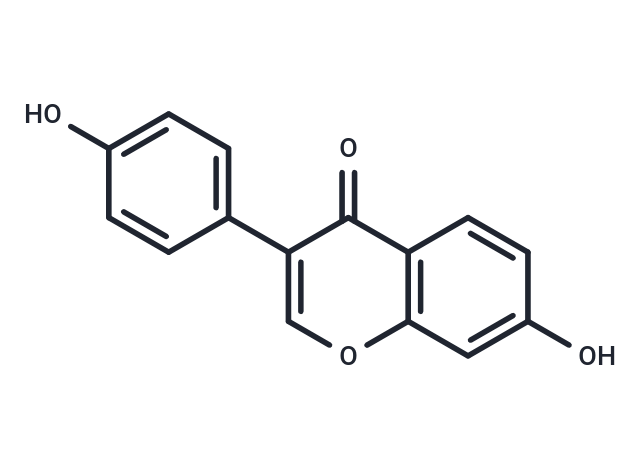Shopping Cart
- Remove All
 Your shopping cart is currently empty
Your shopping cart is currently empty

Daidzein (Isoflavone) is an isoflavone extract from soy, which is an inactive analog of the tyrosine kinase inhibitor genistein. It has antioxidant and phytoestrogenic properties.

| Pack Size | Price | Availability | Quantity |
|---|---|---|---|
| 500 mg | $45 | In Stock | |
| 1 g | $57 | In Stock | |
| 1 mL x 10 mM (in DMSO) | $50 | In Stock |
| Description | Daidzein (Isoflavone) is an isoflavone extract from soy, which is an inactive analog of the tyrosine kinase inhibitor genistein. It has antioxidant and phytoestrogenic properties. |
| In vivo | Daidzein results in reduced body weight, a fact that may be explained by reduced feed consumption in female rats. Daidzein results in slight, but not significant, decreases in ovarian and uterine weights, and mammary gland size in female rats. [5] |
| Cell Research | Daidzein is dissolved in DMSO and then diluted with appropriate media[1]. HEK293T cells are plated on 24-well plates at a cell density of approximately 2.5×104 cells/well and are grown to 70-80% confluence. Cells are then transiently transfected with a PPAR-α or PPAR-γ expression plasmid, and a plasmid containing the luciferase gene under the control of three tandem PPAR response elements (PPRE × 3 TK-luciferase) using an X-treme GENE HP DNA Transfection Reagent. Renilla luciferase control vectors are co-transfected to control for transfection efficiency. After transfection, cells are cultured for another 24 h in medium containing DMSO or various concentrations (6.25, 12.5, 25 μM) of Daidzein. Cells are lysed, and luciferase activity is measured and expressed as fold induction, that is normalized to the activity of the renilla luciferase control plasmid[1]. |
| Alias | Isoflavone |
| Molecular Weight | 254.24 |
| Formula | C15H10O4 |
| Cas No. | 486-66-8 |
| Storage | Powder: -20°C for 3 years | In solvent: -80°C for 1 year | Shipping with blue ice. | |||||||||||||||||||||||||||||||||||
| Solubility Information | DMSO: 45 mg/mL (177 mM) H2O: < 1 mg/mL (insoluble or slightly soluble) | |||||||||||||||||||||||||||||||||||
Solution Preparation Table | ||||||||||||||||||||||||||||||||||||
DMSO
| ||||||||||||||||||||||||||||||||||||

Copyright © 2015-2024 TargetMol Chemicals Inc. All Rights Reserved.